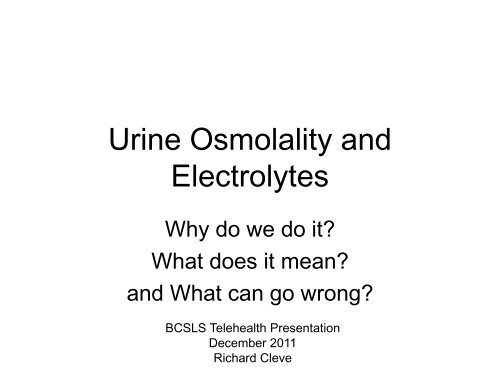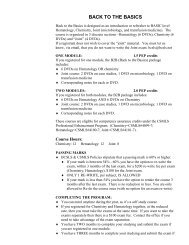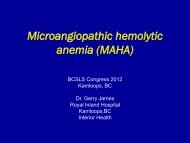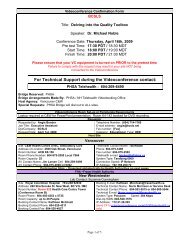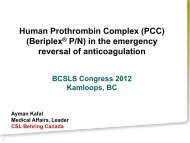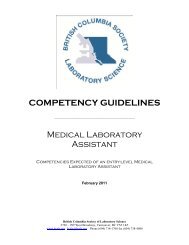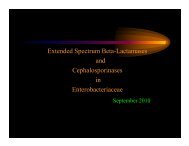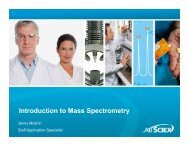Urine Osmolality and Electrolytes
Urine Osmolality and Electrolytes
Urine Osmolality and Electrolytes
Create successful ePaper yourself
Turn your PDF publications into a flip-book with our unique Google optimized e-Paper software.
<strong>Urine</strong> <strong>Osmolality</strong> <strong>and</strong><br />
<strong>Electrolytes</strong><br />
Why do we do it?<br />
What does it mean?<br />
<strong>and</strong> What can go wrong?<br />
BCSLS Telehealth Presentation<br />
December 2011<br />
Richard Cleve
Outline<br />
• Definitions<br />
• Osmometry<br />
• Applications<br />
– Polyuria<br />
– Hyponatraemia<br />
– Renal Failure
Definition<br />
• Concentration<br />
– Number of moles per L of solution<br />
• Osmolarity<br />
number of osmoles per L of solution<br />
• <strong>Osmolality</strong><br />
number of osmoles per kg solvent<br />
• Tonicity<br />
non-penetrating osmoles<br />
• Plasma osmolarity is 1-2% less than osmolality
Colligative properties<br />
• Parameters<br />
proportional to #<br />
osmoles:<br />
– Depressing freezing<br />
point<br />
– Elevating boiling point<br />
– Increasing osmotic<br />
pressure<br />
– Lowering vapour<br />
pressure
<strong>Osmolality</strong> Measurement<br />
FP↓ ΔT ≈ -1.86 C°/osm<br />
Simple, common<br />
BP↑ ΔT ≈ +0.52 C°/osm<br />
Organic compounds<br />
unstable.<br />
VP↓ ΔP ≈ -0.3 mmHg/osm Volatile chemicals<br />
invalidate<br />
OP↑ ΔΠ ≈ 17000<br />
mmHg/osm<br />
Technically hard
Cryoscopic constant<br />
Why “≈” in those equations?<br />
2.6<br />
sucrose<br />
2.4<br />
2.2<br />
Citric acid<br />
2.0<br />
1.8<br />
glycerin<br />
ideal<br />
1.6<br />
0 1 2 3 4<br />
Molal concentration (osm/kg)<br />
Physical Pharmacy 1983 p. 159
Temp<br />
Freezing point osmometry<br />
liquid<br />
Super-cooled<br />
liquid<br />
Ice-liquid<br />
slurry<br />
Solid<br />
0°C<br />
T FP<br />
-5.6°C<br />
time<br />
Percussion
Freezing Point Analytical<br />
Interferents<br />
• High viscosity<br />
• Particles
Specimen
Temp<br />
Dew Point<br />
condensation<br />
equilibrium Cooling No net<br />
condensation<br />
Return to<br />
equilibrium<br />
T equilib.<br />
T DP<br />
time
Methods<br />
• Freezing point depression<br />
– Almost exclusive method now<br />
– Large coefficient so good CV’s<br />
– Simple, robust instruments<br />
• Dew Point<br />
– Invalid for volatiles
Alternative Test<br />
→Refractometry correlates with osmolality<br />
→weaker correlation with dipstick SG <strong>and</strong> osmolality<br />
Limitation: glucose <strong>and</strong> protein lessen relationship<br />
Arch. Dis. Child 85: 155
Specimen<br />
• No special preparation<br />
– Usually need serum/plasma results<br />
• R<strong>and</strong>om urine<br />
– Acute conditions/decisions<br />
– Simple to collect<br />
– Creatinine improves interpretation<br />
• Timed urine<br />
– More reliable (Na excretion is variable)
Normal values<br />
• No normal values for urine electrolytes &<br />
osmolality<br />
• Range of physiologically expected results<br />
– U.osm 50-1200 mosm/kg<br />
– Range narrows as one ages<br />
• “Expected” values depend on clinical<br />
picture
<strong>Urine</strong> Osmolaltiy<br />
• Typical values<br />
– 500-800 mosm/kg (24 hour)<br />
300-900 mosm/kg (r<strong>and</strong>om)<br />
– After 12 hours fasting >850 mosm/kg<br />
– A.m. specimen ≈3 times serum osmolality
<strong>Urine</strong> <strong>Osmolality</strong><br />
• Increased<br />
– Dehydration<br />
– SIADH<br />
– Adrenal insufficiency<br />
– Glycosuria<br />
– Hypernatraemia<br />
– High protein diet<br />
• Decreased<br />
– Diabetes insipidus<br />
– Excess fluid intake<br />
– Renal insufficiency<br />
– glomerulonephritis
<strong>Urine</strong> <strong>Osmolality</strong> Cautions<br />
• EtOH<br />
• Extremes of protein in diet<br />
• Diuretics
Other Specimens<br />
• Pleural, ascitic<br />
– In equilibrium with serum<br />
– Thus, equal to serum<br />
– Rarely indicated<br />
– No special requirements for measurement
Faecal specimens<br />
• Rare test for cause of diarrhoea<br />
• F.osm - 2(F.Na + F.K)<br />
– 150: osmotic diarrhoea<br />
• Laxatives<br />
• Malabsorption (including lactose intolerance)<br />
• Sorbitol, mannitol, lactulose<br />
• Limitation:<br />
– bacterial activity ↑’s gap<br />
– Only very watery specimens
Clinical Indications<br />
• Polyuria<br />
• Hyponatraemia<br />
• Renal failure<br />
• Low anion-gap metabolic acidosis
Polyuria
Case<br />
• 65 year old<br />
• c/o going to the w/c 4 or 5 times/night<br />
• Constantly thirsty<br />
• Drinks 4 or 5 L of ice cold water/day<br />
• <strong>Urine</strong> output measured at 3.5 L/day
Normal <strong>Urine</strong> Output<br />
• 800 mL/d is polyuria
Water & Electrolyte Balance<br />
Na/K/Cl intake<br />
Protein intake<br />
Na/K/Cl output<br />
≈400 mosm/day<br />
Protein (urea) output<br />
≈500 mosm/day<br />
Water intake<br />
Water output<br />
≈900 mosm/1.5 L<br />
≈600 mosm/L
Water Balance<br />
• Metabolism 10%<br />
250mL<br />
• Food 30% 750mL<br />
• Beverages 60% 1500<br />
mL<br />
• Faeces 4% 100 mL<br />
• Sweat 8% 200 mL<br />
• “Insensible” (skin +<br />
lungs) 28% 700 mL<br />
• <strong>Urine</strong> 60% 1500 mL
Water Regulation<br />
hypothalamus<br />
pituitary<br />
↑P.osm<br />
↓saliva<br />
Renin/angiotensin<br />
Dry mouth<br />
ADH<br />
(vasopressin)<br />
↓P.volume<br />
↓BP
Assessing Intravascular Volume<br />
• Clinical (sensitivity ~50%)<br />
– Orthostatic hypotension<br />
– Weak pulse<br />
– Cool extremeties<br />
– HR<br />
– Skin turgor<br />
– Mucous membranes<br />
– JVP<br />
• Investigation<br />
– <strong>Urine</strong> Volume & Colour<br />
– Chest X-ray<br />
– Haemoconcentration<br />
– Creatinine, urea<br />
– Radioactive albumin dilution<br />
– BNP
<strong>Urine</strong> Concentration<br />
300<br />
100<br />
300<br />
H 2 O<br />
400 200<br />
Na/Cl<br />
H 2 O<br />
400<br />
400<br />
H 2 O<br />
600 400<br />
Na/Cl<br />
H 2 O<br />
600<br />
600<br />
H 2 O<br />
900<br />
700<br />
urea<br />
H 2 O,<br />
urea<br />
1200 1200<br />
1200
Polyuria Assessment<br />
osmolality<br />
Polyuria<br />
flow<br />
Osmole<br />
excretion
Polyuria<br />
• 300 mosm/kg<br />
– Solute diuresis
Polyuria<br />
U.Osm<br />
300<br />
“water” diuresis<br />
“osmole” diuresis<br />
DI<br />
Polydipsia<br />
“osmotic” diuresis<br />
Lytes<br />
2(Na+K)<br />
Water Deprivation Test<br />
• Preparation: Patient drinks until 6:00 am<br />
morning of test<br />
• Weight, P.osm, P.Na, U.osm, U.Na<br />
• Nothing to eat/drink during test<br />
• <strong>Urine</strong> hourly<br />
• Stop test if U.osm > 500, P.Na >145,<br />
weight loss >10%.<br />
• +/- DDAVP
Water Deprivation Test<br />
U.osm<br />
1200<br />
normal<br />
500<br />
Psychogenic<br />
polydipsia<br />
Central DI<br />
Nephrogenic DI<br />
Give<br />
ADH<br />
(DDAVP)<br />
time
ADH & plasma osmolality<br />
P.ADH<br />
pg/mL<br />
15<br />
0<br />
SIADH<br />
Normal<br />
&<br />
Psychogenic<br />
polydipsia<br />
Nephrogenic<br />
Diabetes<br />
Insipidus<br />
Central<br />
Diabetes<br />
Insipidus<br />
280 290 300 310<br />
P.osmolality, mOsm/kg
Hyponatraemia
Renal H<strong>and</strong>ling<br />
• Average 70 kg male<br />
filters approximately<br />
1.2 kg of salt per day!<br />
• Vast majority must be<br />
reabsorbed
<strong>Urine</strong> Sodium<br />
70-80%<br />
Freely filtered<br />
5-10%<br />
Na/K/H<br />
20-25%<br />
Na/K/2Cl
Dysnatraemia<br />
Amount of salt<br />
mmol<br />
L<br />
Amount of water
Case<br />
• 6 month old with astrocytoma on<br />
vincristine<br />
• P.Na 126 L 135-145 mmol/L<br />
• P.Osm 255 L<br />
U.Na 32<br />
280-300 mosm/kg<br />
• Cerebral salt wasting vs SIADH
Hyponatraemia<br />
Serum osmolality<br />
>300
Case…<br />
• SIADH:<br />
– Kidneys act to preserve perfusion<br />
– SIADH = excess of water, hence intravascular<br />
volume, in face of low Na.<br />
– Kidney response is to lose Na<br />
• Cerebral Salt Wasting<br />
– Inappropriate Na excretion →<br />
↑urine volume →<br />
↓intravascular volume
SIADH<br />
• Laboratory Features<br />
– ↓S.Na<br />
– ↓P.osm<br />
– ↑U.osm (typ. >50 mosm/L)<br />
– U.Na >20 mmol/L<br />
– Normal renal, thyroid & adrenals<br />
– Euvolaemic
SIADH Causes<br />
• Tumour<br />
– Small cell, bronchogenic CA, pancreatic, Hodgkin’s<br />
• Pulmonary<br />
– Pneumonia, lung abscess, TB<br />
• Medications<br />
– NSAID, barbiturates, carbamazepine, TCA, oxytocin<br />
• CNS<br />
– Brain tumour, encephalitis, SAH, AIP, trauma<br />
• AIDS<br />
• Ventilation<br />
• Post-operative
SIADH Treatment<br />
• Water restriction (~1 L/day)<br />
• Salt<br />
• Weigh daily<br />
• Loop diuretic<br />
• Urea (rarely used)
Cautions<br />
• No renal or adrenal problems<br />
• No bicarbonaturia<br />
– Obligate excretion of Na<br />
– E.g. recent vomiting<br />
• No carbonic anhydrase inhibitors<br />
• No acid/base disturbance<br />
• No diuretics
Hyponatraemia<br />
• Reset osmostat<br />
– Test: water load to further drop S.Na<br />
– Rarely performed test<br />
– Only done in patients with mild hyponatraemia<br />
– SIADH → urine remains concentrated<br />
– Reset osmostat → urine becomes dilute<br />
• Importance: treatment different
Treatment cautions<br />
• Dangerous to correct too correctly<br />
• Central pontine myelinolysis<br />
• ↑Na by 1-2 mmol/L/h,<br />
maximum of 8 mmol/L/day
Hypernatraemia<br />
• Very rarely need urine studies<br />
– Can be used as an adjunct study
<strong>Urine</strong> Potassium<br />
• Less predictable due to many influences<br />
– Potassium intake variable<br />
– Na effects via aldosterone<br />
– Hydration<br />
• Range 10-400 mmol/d<br />
• Transtubular potassium gradient<br />
– Can be calculated<br />
– Clinically doesn’t add much information<br />
– Rarely used now
Renal Failure
Renal Failure Classifications<br />
• Duration<br />
– Acute renal failure<br />
– Chronic renal failure<br />
• Location<br />
– Pre-renal<br />
– Renal<br />
– Post-renal
• Pre-renal<br />
– Dehydration<br />
– CHF<br />
– Arterial supply<br />
• Renal<br />
– Glomeruli<br />
– Renal tubules<br />
– Interstitium<br />
• Post-renal<br />
– Stone<br />
– Tumour<br />
– Prostate<br />
Renal Failure
Fractional Excretion<br />
• Corrects for urine concentration<br />
• FENa = [U.Na * P.Cr]/[U.Cr * P.Na]<br />
• N.B. match units<br />
– Plasma creatinine in μmol/L<br />
– <strong>Urine</strong> creatinine in mmol/L<br />
• FeNa 1% renal
Case #1<br />
• 50 y.o. goes to the ER with history of<br />
vomiting <strong>and</strong> diarrhoea. Looks dehydrated<br />
Plasma.Na 140<br />
Plasma.Cre 150 HΔ<br />
135-145 mmol/L<br />
umol/L<br />
U.Na 25 mmol/L<br />
U.Cre 1 mmol/L<br />
FENa 2.7%<br />
U.osm 320 mosm/kg
Case #2<br />
• 50 y.o. goes to the ER with history of<br />
vomiting <strong>and</strong> diarrhoea. Looks dehydrated<br />
Plasma.Na 140<br />
Plasma.Cre 150 HΔ<br />
135-145 mmol/L<br />
umol/L<br />
U.Na 25 mmol/L<br />
U.Cre 10 mmol/L<br />
FENa 0.27%<br />
U.osm 600 mosm/kg
Interpretation<br />
• FENa 3% -- acute kidney injury<br />
• U.Osm >500 – pre-renal<br />
• U.Osm
Caution<br />
• Loop diuretics increase FENa<br />
– Cannot interpret while on diuretics<br />
• Severe protein malnutrition/starvation or<br />
wash-out of kidney
RTA
Metabolic Acidosis<br />
• Increased anion gap<br />
– Relatively straight-forward<br />
– “MUDPILES”<br />
• Normal anion gap<br />
– Factitious<br />
• Hypoalbuminaemia<br />
• Unusual cations (e.g. monoclonal b<strong>and</strong>)<br />
– HCl or NH 4 Cl loading<br />
– HCO 3 loss<br />
• GI (diarrhoea, illeus)<br />
• Renal (proximal RTA, carbonic anhydrase inhibitor)<br />
– Failure to generate “new” bicarbonate (distal RTA)<br />
– Gain of an acid with excretion of conjugate base
Acid production<br />
• Typical North American diet produces<br />
1 mmol H + /kg body weight/day<br />
• Mainly from protein oxidation<br />
• Buffering acid load consumes equivalent<br />
amount of bicarbonate.<br />
• S.pH ~7.4, U.pH ~6.0
Renal Acid-Base: Recovery<br />
Blood Renal Tubular Cell <strong>Urine</strong><br />
Na + HCO 3<br />
-<br />
Na + Na +<br />
HCO 3<br />
-<br />
+ H + H+<br />
H 2 CO 3<br />
NaHCO 3<br />
CO 2<br />
CO 2 + H 2 O
Renal Acid-Base: Loss of H +<br />
Blood Renal Tubular Cell <strong>Urine</strong><br />
CO 2 + H 2 O<br />
NaHCO 3<br />
Na 2 HPO 4<br />
HCO<br />
-<br />
3 + H + H +<br />
NaHPO 4<br />
Na + Na +<br />
glutamine<br />
NH NH<br />
3<br />
3<br />
glutamate<br />
NH<br />
+<br />
4<br />
NH NH<br />
3<br />
3<br />
α-KG
Ammonia<br />
• Theoretically can be measured; however,<br />
technically very difficult in urine<br />
• Essentially research-only method<br />
• Calculating
Electroneutrality<br />
+ Na +<br />
+ K +<br />
+ 2Ca ++<br />
+ 2Mg ++<br />
+ NH4 +<br />
+ Cl -<br />
+ HCO<br />
-<br />
3<br />
+ H 2 PO<br />
-<br />
4<br />
+ 2HPO<br />
=<br />
4<br />
+ 2SO<br />
=<br />
4<br />
+ organic anions
Electroneutrality<br />
+ Na +<br />
+ K +<br />
+ 2Ca ++<br />
+ 2Mg ++<br />
+ NH4 +<br />
≈80 mEq/day<br />
+ Cl -<br />
+ HCO<br />
-<br />
3<br />
+ H 2 PO<br />
-<br />
4<br />
+ 2HPO<br />
=<br />
4<br />
+ 2SO<br />
=<br />
4<br />
+ organic anions<br />
Na + + K + + NH4 + = Cl - + 80<br />
NH4 + α Na + + K + - Cl -
Cautions of net charge<br />
• Unmeasured anions → underestimate<br />
NH4<br />
– Ketonuria<br />
– DKA<br />
– Drugs (penicillin, salicylates)
Non-Anion gap Metabolic Acidosis<br />
Na+K-Cl<br />
Negative<br />
(high NH 4+ )<br />
Positive<br />
(low NH 4+ )<br />
GI bicarb loss<br />
Acetazolamide<br />
NH 4 Cl, HCl<br />
Conclusions
<strong>Urine</strong> <strong>Osmolality</strong> & Lytes Utility<br />
• Rarely needed, but critical test<br />
– Polyuria<br />
– Hypernatramia<br />
– Supportive role<br />
• Pre-renal vs renal oliguria<br />
• Integrity of the medullary interstitium
Summary<br />
• No “normal” ranges – interpret in clinical<br />
context<br />
• Cautions:<br />
– No diuretics<br />
– No adrenal or thyroid disease<br />
– Relatively normal diet


